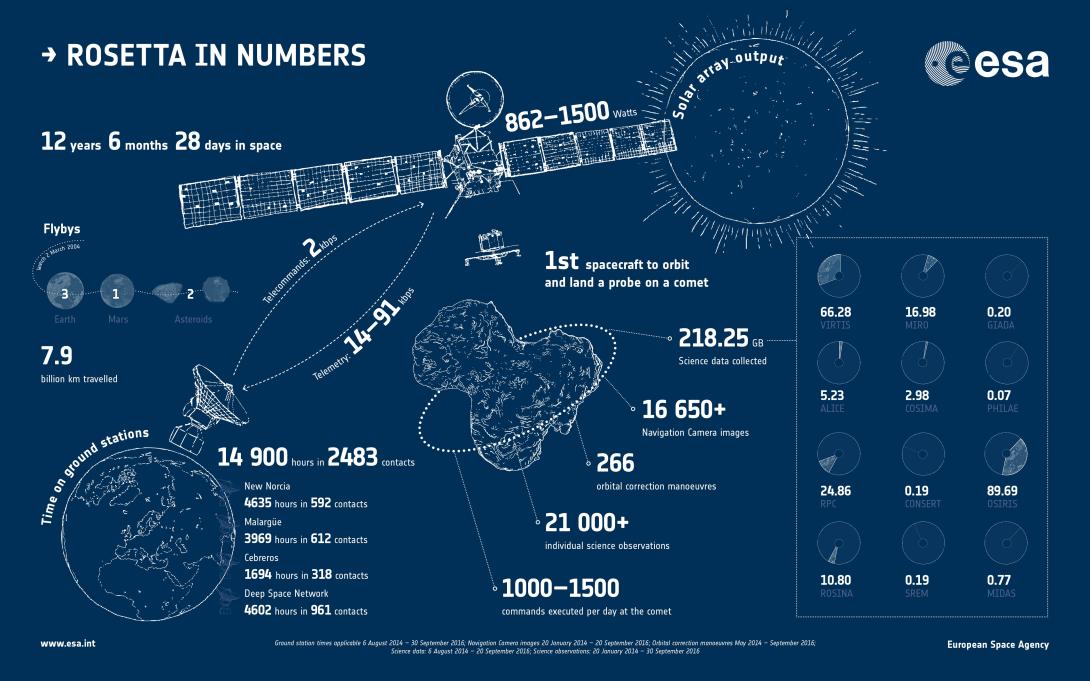Mission
Rosetta

ESA's Rosetta mission was the first to rendezvous with a comet, the first to follow a comet on its orbit around the Sun, and the first to deploy a lander to a comet's surface.
Comets are time capsules containing primitive material left over from the epoch when the Sun and its planets formed. By studying the gas, dust and structure of the nucleus and organic materials associated with the comet, via both remote and in situ observations, Rosetta continues to help scientists unlock the history and evolution of our Solar System long after the mission’s end.
Rosetta's main objective was to rendezvous with and enter orbit around Comet 67P/Churyumov-Gerasimenko, performing observations of the comet's nucleus and coma. On 12 November 2014, at 17:32 GMT, Rosetta's Philae lander made the first-ever landing on a comet.
Rosetta was an ESA mission flown from ESOC with contributions from its Member States and NASA. Rosetta’s Philae lander was provided by a consortium led by DLR, MPS, CNES and ASI.
The planned launch date for Rosetta was 07:36:49 GMT on 26 February 2004. However, an initial delay due to adverse weather, and a subsequent delay due to a technical issue with the launch vehicle, pushed the launch date back by five days, to 2 March 2004.
Read more about the scientific goals of the mission here.

Journey
Rosetta’s interplanetary journey was a masterpiece of flight dynamics and mission operations. During its 10-year journey to Comet 67P/Churyumov-Gerasimenko, operators at ESOC navigated Rosetta around the Sun almost four times, across the asteroid belt twice and past the planets to gain velocity from gravitational 'kicks' during precise flybys of Mars (2007) and Earth (2005, 2007 and 2009).
The teams at ESOC had to contend with the decade-long mission duration and the orbit of a small, dark and distant comet had to be predicted as far as 15 years in advance. The vast distances involved also meant a long turnaround times for signals (up to 100 minutes), low bit rates for data (8 bps) and low power availability – Rosetta was the first spacecraft ever to fly with solar power generators beyond 3.1 AU from the Sun (~460 million km).
During May-August 2014, operators conducted a series of 10 incredibly precise, incredibly distant orbit correction manoeuvres to phase Rosetta’s orbit with that of the comet. One of these thruster burns, conducted on 21 May 2014, was one of the longest-ever burns carried out by an ESA spacecraft.
Ground segment
The central element of the Rosetta ground segment, the Mission Control System, was based on the SCOS-2000 software designed at ESOC and used as a base for the control systems of dozens of spacecraft at ESOC and across Europe. Rosetta also marked an important step in an ongoing journey at ESOC. The use of shared software across multiple missions offers great potential to increase the efficiency of mission operations, which was demonstrated when large parts of the Rosetta mission planning system were designed to be shared with the BepiColombo mission to Mercury.
The Rosetta mission was controlled from the Rosetta Mission Operations Centre (MOC) at ESOC in Darmstadt, using the ground stations in ESA’s global Estrack network, supported by the NASA Deep Space Network (DSN).
The Rosetta Science Operations Centre (RSOC) was located at ESA’s ESAC, near Madrid. A Rosetta Lander Ground Segment (RLGS) controlled the Philae lander, coordinated through the Lander Control Centre at the German Aerospace Center (DLR) in Cologne, Germany, and the lander scientific control centre of the French space agency, CNES, in Toulouse.
Arrival at the comet
On 6 August 2014, when Rosetta was just 100 kilometres from the comet’s surface, spacecraft operators at ESOC conducted an orbit manoeuvre that kicked the spacecraft onto the first leg of a pair of triangular-shaped trajectories passing in front of the comet, first at a distance of 100 kilometres and then at 50 km, followed by a close, near-circular orbit at 30 kilometres.
Selecting Philae’s landing site
On 25 August 2014, using detailed information collected by Rosetta during its first two weeks at Comet 67P/Churyumov-Gerasimenko, five locations on the moving target were identified as candidate sites to set down the Philae lander in November of that year. A final prime landing site, named Agilkia (plus a backup), was announced in early November.
Landing on 67P/C-G
Philae touchdown on the comet was confirmed at ESOC at 16:03 GMT/17:03 CET on 12 November. Analysis of data from Philae later revealed that the lander did not just touch down once, but three times, as the craft's harpoons did not fire, allowing it to rebound into space again. It continued travelling for 1 hour 50 minutes; during that time, it travelled about 1 kilometres at a speed of 38 cm/s. It then made a smaller second hop, travelling at about 3 cm/s, landing in its final resting place seven minutes later.
Read more about the Philae lander and its historic comet landing here.
Mission end
Squeezing out unique scientific observations until the very end, Rosetta’s mission culminated with a descent on 30 September 2016 towards a region of active pits on the comet’s ‘head’. The region, known as Ma’at, lies on the smaller of the two lobes of Comet 67P/Churyumov–Gerasimenko. It is home to several active pits more than 100 m in diameter and 50–60 m in depth – where a number of the comet’s dust jets originate.
